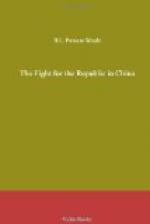form of government was the ideal form, it was
suitable for any country and any people. The idea
thus quickly spread and almost every country became
a republic. The independence of these countries,
however, was secured only at the cost of a hard struggle
and once the spirit of rebellion was aroused it became
difficult to suppress in a short while. And
since education was not then universal the intellect
of the people was low. What they were expert
in was in autocratic methods. No task is harder
than to establish a republic in a country, the
intelligence of whose people is low. These
republics, therefore, reaped no good results although
they tried to retain republicanism unnaturally.
The consequence is that the republics of Central
and South America have been a living drama of
continuous internal disturbance. One after another
their military leaders have grasped the power
of administration. Occasionally there has
been peace but this peace has only been secured
by the iron hand of one or two powerful men holding
the power. Such powerful men, however, seldom
pay any attention to educational matters, and
one never hears of their establishing any schools.
As to the people under them, they are not allowed to
participate in political affairs by which their
experience in politics may be ripened. The
result is, on the man in power becoming sick or
dying—and the iron rule relaxed—that
those who wish to usurp the power of the state
rise at once; and as the satisfactory solution
of the problem of succession cannot be found, those
undertakings which have made progress during the
time of peace are swept away without a single
exception. In extreme cases the disturbances
continue to such an extent that the country falls into
a state of anarchy. Thus the social and financial
factors of the whole country are trodden on and
destroyed under foot.
The conditions now prevailing in Mexico have been many times duplicated in other republics in Central and South America. For this can be the only result from adopting the republican form of government where the political and financial conditions are unsuited. Diaz, a military leader, once held the power of state in his own hand, and when he became the President of Mexico it looked as if the political problem was solved thereby. Diaz, however, did not push education but instead oppressed the people and did not allow them to participate in politics. When he was advanced in age and his influence decreased, he lost entire control once the banner of rebellion was raised. Ever since the overthrow of Diaz, military leaders of that country have been fighting one another and the disturbance is developing even to-day. In the present circumstances there is no other means to solve the political problem of Mexico except by intervention from abroad. (Sic.)
Among the republics of Central and South America, however, there are some which have made fairly good progress, the most prominent of which




